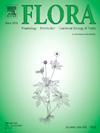塞尔维亚大戟属分类群的解剖特征:分类鉴定意义
IF 1.8
4区 生物学
Q3 ECOLOGY
引用次数: 0
摘要
本文研究了塞尔维亚11种大戟属植物(E.上皮植物、E. niciciana植物、E. serpentini植物、E. spinosa亚种植物)茎叶性状的解剖变异及其分类意义。本文首次研究了光花草(glabriflora)、花花草(E. subhastata)和花花草(E. thessala)。采用单因素和多因素统计分析,对31个定量解剖特征进行测量和分析。主要的区分性状包括茎粗、茎厚、皮层薄壁组织厚度、木质部厚度、正面气孔宽度和背面气孔表面积。这些发现强调了定量解剖特征在分类群鉴定中的诊断价值。此外,质量特征——特别是表皮特征,如毛被、细胞壁模式和气孔类型——进一步有助于分类群的分化。本研究首次对所研究的大部分分类群的茎和叶进行了全面的解剖分析,增强了对大戟属植物变异模式的理解。它支持更精确的属内分类划分,并为今后的研究奠定了基础。本文章由计算机程序翻译,如有差异,请以英文原文为准。
Anatomical characterisation of Euphorbia L. taxa from Serbia: implications for taxonomy and identification
This study examines the anatomical variability of stem and leaf traits and their taxonomic significance in 11 Euphorbia species and subspecies from Serbia, six of which (E. epithymoides, E. niciciana, E. serpentini, E. spinosa subsp. glabriflora, E. subhastata, and E. thessala) are investigated for the first time. A total of 31 quantitative anatomical characters were measured and analysed using univariate and multivariate statistical analyses. Key differentiating traits included stem diameter, stem collenchyma thickness, cortex parenchyma thickness, xylem thickness, width of stomata on the adaxial side, and stomatal surface area on the abaxial side. The findings underscore the diagnostic value of quantitative anatomical traits for taxa identification. Additionally, qualitative traits - particularly epidermal features such as indumentum, cell wall patterns, and stomatal types - further aid in taxa differentiation. This study provides the first comprehensive anatomical analysis of stems and leaves for most of the taxa examined, enhancing the understanding of Euphorbia variability patterns. It supports more precise taxa delimitation within the genus and establishes a foundation for future research.
求助全文
通过发布文献求助,成功后即可免费获取论文全文。
去求助
来源期刊

Flora
生物-植物科学
CiteScore
3.30
自引率
10.50%
发文量
130
审稿时长
54 days
期刊介绍:
FLORA publishes original contributions and review articles on plant structure (morphology and anatomy), plant distribution (incl. phylogeography) and plant functional ecology (ecophysiology, population ecology and population genetics, organismic interactions, community ecology, ecosystem ecology). Manuscripts (both original and review articles) on a single topic can be compiled in Special Issues, for which suggestions are welcome.
FLORA, the scientific botanical journal with the longest uninterrupted publication sequence (since 1818), considers manuscripts in the above areas which appeal a broad scientific and international readership. Manuscripts focused on floristics and vegetation science will only be considered if they exceed the pure descriptive approach and have relevance for interpreting plant morphology, distribution or ecology. Manuscripts whose content is restricted to purely systematic and nomenclature matters, to geobotanical aspects of only local interest, to pure applications in agri-, horti- or silviculture and pharmacology, and experimental studies dealing exclusively with investigations at the cellular and subcellular level will not be accepted. Manuscripts dealing with comparative and evolutionary aspects of morphology, anatomy and development are welcome.
 求助内容:
求助内容: 应助结果提醒方式:
应助结果提醒方式:


